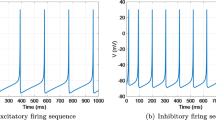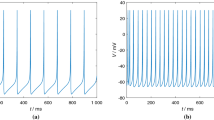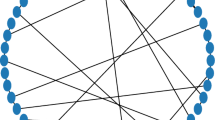Abstract
Neural information coding is the fundamental of information processing mechanism in biological neural network. The study of neural information coding can help to understand the function of information processing in biological neural network and lay the theoretical foundation for improving bionic ability. As the abstract of a large number of real complex systems, small-world networks have the properties of biological neural networks. However, the neural information coding based on the small-world topology is rarely studied and the information transmission mechanism among the neurons is mostly excitatory regulation mechanism of spike-timing-dependent plasticity (STDP). In this paper, the small-world network is constructed and its properties are analyzed; the small-world spiking neural network based on the more complete STDP including excitatory synapse and inhibitory synapse is constructed; from the angle of firing rate of neurons and the temporal structure of the spike train, the properties of information coding on the small-world spiking neural network under the stimulations of white Gauss noise and impulse noise are analyzed respectively. Our experimental results indicate that under the same stimulation, the responses of the mean rate coding and ISI coding of the small-world network are both enhanced with the increase of stimulation intensity; under different stimulations, the mean rate coding and ISI coding of the small-world network show respective specificity.













Similar content being viewed by others
References
Yu, K., Wang, J., Deng, B., Wei, X.L.: Synchronization of neuron population subject to steady DC electric field induced by magnetic stimulation. Cogn. Neurodyn. 7, 237–252 (2013)
Laurent, G., Wehr, M., Davidowitz, H.: Temporal representations of odors in an olfactory network. J. Neurosci. 16, 3837 (2001)
Panzeri, S., Harvey, C.D., Piasini, E.: Cracking the neural code for sensory perception by combining statistics, intervention, and behavior. Neuron 93, 491 (2017)
Parker, D.: Neuronal network analyses: premises, promises and uncertainties. Philos. Trans. R. Soc. Lond. 365, 2315–28 (2010)
Zemanová, L., Zamora-López, G., Zhou, C.: Complex brain networks: from topological communities to clustered dynamics. Pramana 70, 1087–1097 (2008)
van Rossum, M.C.W., Turrigiano, G.G., Nelson, S.B.: Fast propagation of firing rates through layered networks of noisy neurons. J. Neurosci. 22, 1956–1966 (2002)
Yu, H., Guo, X., Wang, J.: Spike coherence and synchronization on Newman–Watts small-world neuronal networks modulated by spike-timing-dependent plasticity. Physica A 419, 307–317 (2015)
Haibo, Q.U., Su, L.U., Zhang, W.: Analysis of the characteristics of infantile small world neural network node properties correlated with the influencing factors. J. Biomed. Eng. 33, 931–938 (2016)
Litwinkumar, A., Doiron, B.: Formation and maintenance of neuronal assemblies through synaptic plasticity. Nat. Commun. 5, 5319 (2013)
Rumbell, T., Denham, S.L., Wennekers, T.: A spiking self-organizing map combing STDP, oscillations and continuous learning. IEEE Trans. Neural. Netw. Learn. Syst. 25, 894–907 (2014)
Wei, Y., Koulakov, A.A.: Long-term memory stabilized by noise-induced rehearsal. J. Neurosci. 34, 15804–15815 (2014)
Goudar, V., Buonomano, D.V.: A model of order-selectivity based on dynamic changes in the balance of excitation and inhibition produced by short-term synaptic plasticity. J. Neurophysiol. 113, 509–523 (2015)
Wang, R., Wu, Y., Wang, L.: Structure and dynamics of self-organized neuronal network with an improved STDP rule. Nonlinear Dynam. 1, 1–14 (2017)
Effenberger, F., Jost, J., Levina, A.: Self-organization in balanced state networks by STDP and homeostatic plasticity. PloS Comput. Biol. 11, e1004420 (2015)
Rumbell, T., Denham, S.L., Wennekers, T.: A spiking self-organizing map combining STDP, oscillations, and continuous learning. IEEE Trans. Neural Netw. Learn. Syst. 25, 894–907 (2014)
Wang, M.L., Wang, J.S.: Dynamical balance between excitation and inhibition of feedback neural circuit via inhibitory synaptic plasticity. Acta Phys. Sin. 64, 416–423 (2015)
Yu, H.T., Wang, J., Liu, Q.X., Deng, B., Wei, X.L.: Delayed feedback control of bursting synchronization in small-world neuronal networks. Neurocomputing 99, 178–187 (2013)
Mikkelsen, K., Imparato, A., Torcini, A.: Emergence of slow oscillations in neural networks with spike-timing dependent plasticity. Phys. Rev. Lett. 110, 208101 (2013)
Guo, L., Wang, Y., Yu, H.: Study of brain functional network based on sample entropy of EEG under magnetic stimulation at PC6 acupoint. Bio-med. Mater. Eng. 24, 1063–1069 (2014)
Guo, L., Wang, Y., Yu, H.: Brain functional network based on approximate entropy of EEG under magnetic stimulation at acupuncture point. Trans. CES 30, 31–38 (2015)
Izhikevich, E.M.: Simple model of spiking neurons. IEEE Trans. Neural Netw. 14, 1569 (2003)
Srinivasa, N., Cho, Y.: Unsupervised discrimination of patterns in spiking neural networks with excitatory and inhibitory synaptic plasticity. Front. Comput. Neurosci. 8, 159 (2014)
Kleberg, F.I., Fukai, T., Gilson, M.: Excitatory and inhibitory STDP jointly tune feedforward neural circuits to selectively propagate correlated spiking activity. Front. Comput. Neurosci. 8, 53 (2014)
Vogels, T.P., Sprekeler, H., Zenke, F.: Inhibitory plasticity balances excitation and inhibition in sensory pathways and memory networks. Science 334, 1569–1573 (2011)
Song, S., Miller, K.D., Abbott, L.F.: Competitive Hebbian learning through spike-timing-dependent synaptic plasticity. Nat. Neurosci. 3, 919–926 (2010)
Perrinet, L., Delorme, A., Samuelides, M.: Networks of integrate-and-fire neuron using rank order coding A: how to implement spike time dependent Hebbian plasticity. Neurocomputing 38–40, 817–822 (2001)
Tsubo, Y., Isomura, Y., Fukai, T.: Power-law inter-spike interval distributions infer a conditional maximization of entropy in cortical neurons. PloS Comput. B 8, e1002461 (2012)
George, D., Sommer, F.T.: Computing with inter-spike interval codes in networks of integrate and fire neurons. Neurocomputings 65–66, 415–420 (2005)
Yang, Y., Ramamurthy, B., Neef, A.: Low somatic sodium conductance enhances action potential precision in time-coding auditory neuron. J. Neurosci. 36(47), 11999–12009 (2016)
Acknowledgements
This work was supported by National Natural Science Foundation of China (Nos. 61571180, 31400844) and Natural Science Foundation of Hebei Province (No. E2016202128).
Author information
Authors and Affiliations
Corresponding author
Rights and permissions
About this article
Cite this article
Guo, L., Zhang, W. & Zhang, J. Neural information coding on small-world spiking neuronal networks modulated by spike-timing-dependent plasticity under external noise stimulation. Cluster Comput 22 (Suppl 3), 5217–5231 (2019). https://doi.org/10.1007/s10586-017-1188-6
Received:
Revised:
Accepted:
Published:
Issue Date:
DOI: https://doi.org/10.1007/s10586-017-1188-6




